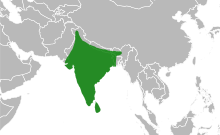
Back Makpou Afrikaans Pavo cristatus AN طاووس هندي Arabic طاووس هندى ARZ मोर AWA Adi tovuz quşu Azerbaijani Merak India BAN Обикновен паун Bulgarian भारतीय मोर Bihari ভারতীয় ময়ূর Bengali/Bangla
| Indian peafowl | |
|---|---|

| |
| Peacock in Nagarhole National Park | |

| |
| Peahen in Bandipur National Park | |
| Scientific classification | |
| Domain: | Eukaryota |
| Kingdom: | Animalia |
| Phylum: | Chordata |
| Class: | Aves |
| Order: | Galliformes |
| Family: | Phasianidae |
| Genus: | Pavo |
| Species: | P. cristatus
|
| Binomial name | |
| Pavo cristatus | |

| |
| Map showing native range | |
The Indian peafowl (Pavo cristatus), also known as the common peafowl or blue peafowl, is a peafowl species native to the Indian subcontinent. While it originated in the Indian subcontinent, it has since been introduced to many other parts of the world. Male peafowl are referred to as peacocks, and female peafowl are referred to as peahens, although both sexes are often referred to colloquially as a "peacock".
The Indian peafowl displays a marked form of sexual dimorphism. The brightly coloured male has a blue coloured head with a fan-shaped crest and is best known for their long train. The train is made up of elongated upper-tail covert feathers with colourful eyespots. These stiff feathers are raised into a fan and quivered in a display during courtship. The peahen is predominantly brown in colour, with a white face and iridescent green lower neck, and lack the elaborate train. There are several colour mutations of the Indian peafowl including the leucistic white peafowl.
Despite the length and size of the covert feathers, the peacock is still capable of flight. The peafowl lives mainly on the ground in open forests or on cultivable lands where it forages for berries and grains, and also preys on snakes, lizards and small rodents. It makes loud calls, which makes it easier to detect, and are often used to indicate the presence of a predator in the forest areas. It forages on the ground in small groups and usually escapes on foot through undergrowth and avoids flying, though it flies into tall trees to roost.
The function of the Indian peacock's elaborate train has been debated for more than a century. In the 19th century, Charles Darwin found it a puzzle, hard to explain through ordinary natural selection. His later explanation, sexual selection, is widely but not universally accepted. In the 20th century, Amotz Zahavi argued that the train was a handicap, and that males were honestly signalling their fitness in proportion to the splendour of their trains. Despite extensive study, opinions remain divided on the mechanisms involved.
The Indian peafowl is listed as Least Concern on the IUCN Red List. It is the national bird of India and venerated in Hindu and Greek mythology.
- ^ BirdLife International (2016). "Pavo cristatus". IUCN Red List of Threatened Species. 2016: e.T22679435A92814454. doi:10.2305/IUCN.UK.2016-3.RLTS.T22679435A92814454.en. Retrieved 2 January 2022.
